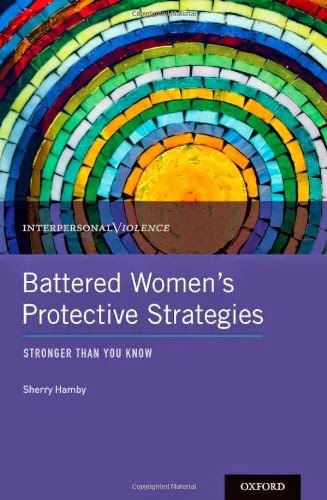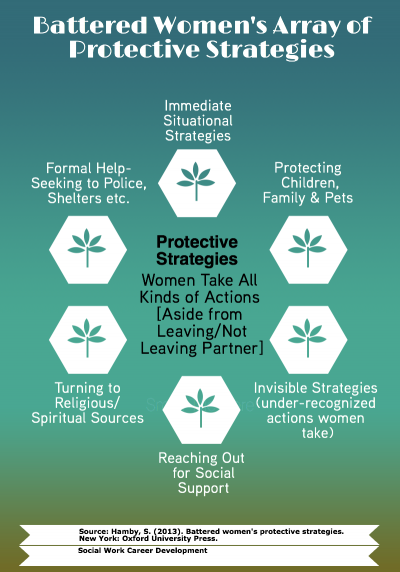Do you work with women who are physically abused and wonder how best to help them?
Contrary to public opinion and the views of many domestic violence agencies, leaving the batterer is not necessarily the only or best solution available to intimate violence survivors.
Sherry Hamby proposes in her book: Battered Women’s Protective Strategies, an innovative and strengths-based approach to this dilemma. Hamby recommends broadening the way one looks at dangerous assessment and safety planning so as to not only fully capture the complexities of the lives that women are facing, but to also recognize the many coping strategies they are already employing.
Why is it important to take a more holistic approach to the risks that domestic violence survivors face?
The traditional framework tends to stigmatize battered women who do not leave their abusers as being passive and in denial.
It is only by acknowledging and understanding all the potential risks and losses that battered women are facing, that we can comprehend and appreciate the protective strategies that they are utilizing and suggest additional helpful measures that fit their particular situations.
2 Common Myths:
- Leaving the abuser always stops the violence.
- The only way to stop the cycle of battering is to end the relationship.
Myth 1: Leaving the Abuser Always Stops the Violence
Leaving may not stop the violence. It might even place the woman’s life in greater danger.
Women are at increased risk for death or serious injury once they leave or share their plans to leave.
Myth 2: The Only Way to Stop the Cycle of Battering Is to End the Relationship
This is not true. Some women strive to achieve a state of “non-violence” and manage to address the issue of violence from within their relationship.
Hamby cites a number of different research studies in support of this approach such as community samples (Jasinski, 2001), military samples (Rabenhorst et al., 2012) and couples who have participated in therapy (O’Leary et al., 1999; Stith & McCollum, 2011).
Financial Constraints that Intimate Violence Survivors Often Face When Leaving:
• Lack of money for security deposit and other moving costs
• Lack of money to file for divorce or pay for a lawyer
• Unemployment
• A much lower standard of living or fall into poverty
As a result of finances being such a critical component to one’s survival, financial dependence is one of the most common reasons that victimized women do not leave.
Many abused women need assistance in finding [and keeping] jobs and obtaining financial assistance.
Good stable employment is often difficult for victims to achieve because on-the-job harassment and/or violence often interfere with their ability to achieve and/or retain work.
According to Postmus (2010):
- 35 to 56% of battered women report being harassed at work
- 24 to 52% report losing their jobs due to violence
I highly recommend Battered Women’s Protective Strategies for any social worker, mental health professional or intimate violence advocate. It provides a comprehensive review of the wide variety of issues that domestic violence survivors face, the broad range of protective coping skills they employ, as well as an innovative risk assessment and management tool [VIGOR] that would apply for women with both considerable and few resources.
The book includes the following sections:
- Re-framing of Stereotypes of Battered Women
- A Holistic Approach to the Complex Problem of Battering
- Protective Strategies/The Multitude of Risks Batterers Can Create
- Financial and Institutional Issues that Constrain Coping
- Additional Influences on Coping Strategies [Social, Practical and Personal]
- Immediate Situational Strategies
- Protecting Children, Family, Friends, Co-Workers and Pets
- Reaching Out for Social Support and Navigating the Challenges of Information Management
- Spiritual and Religious Resources
- Formal Resources
- Invisible Strategies
- A More Holistic Approach to Services and Tools for Intervention
- Conclusion: Recognizing Protective Strategies Can Create Progress
Domestic violence survivors are also likely to find Hamby’s book an invaluable resource, as well as a source of much needed recognition and validation for all the difficulties they face and their creative [but previously overlooked] coping strategies.
This validation is especially priceless in a world that negatively stereotypes women who have not left their abusers and is legally biased in favor of the abuser.
For ex., regardless of the violence, abusers are likely to receive equal or full custody of children they have with their battered wives and child protection agencies often threaten to remove children from the homes of domestic violence survivors when women do not leave their batterers.
In sum, as a result of the differences in the many risks and concerns that different women face, there is no one size fits all intervention strategy.
An effective safety planning and risk assessment is one that is personalized and adapted to reflect a victim’s specific strengths, needs and risks and the way she prioritizes her risks.
What are your thoughts about this book and/or domestic violence? Please share your thoughts below.




Sounds like an interesting book. I wonder if the book addresses some of the technology challenges:women being tracked via their cell phones, etc.
I also wonder about cultural differences and also the differences in women who live in urban areas with a lot of services as opposed to those in rural areas.
I agree that a holistic approach, that includes the woman in the decisions and builds on her strength would be beneficial.
Hi Dima,
Thanks so much for stopping by and sharing your thoughts about this post 🙂
You raised some excellent questions/concerns. Technology issues are presented on both the risks side [as you mention, women need to be concerned about being tracked] as well as on the protective strategies side [there are steps/actions that women may employ to their benefit in this arena].
The beauty of this approach is it looks at a whole of factors that are unique to each woman and that includes cultural factors and availability of resources to that specific woman [all of which may also change over time] – all of these combine to play a role on both the evaluation of risks/losses the woman faces and the protective strategies/help tools she may want to employ.
The woman may then work together with a domestic violence advocate or mental health professional and figure out what it is that she wants and needs to do next in her life based upon her current assessment of the risks/losses she is facing and the strategies she has in place and the available resources she may tap into.
Hi Dima, Thanks for your comments. Technology issues are covered, as Dorlee mentioned, in multiple places and also built into the VIGOR safety plan. We need to bring our tools in the 21st century.
I live in a very rural area in Appalachia and I agree that different responses are needed for rural areas. Many of the examples in the book compare rural and urban issues, such as availability of public transportation.
Thanks for a thoughtful and concise summary, Dorlee of this important book.
Sounds like the author is quite brave(in challenging myths) in her approach to this issue. I guess I did buy into the myth that the best approach in working with battered women was to encourage them to make a plan to leave the batterer.
I thought that the cycle of violence continued and often got much worse and could lead to death for the battered women, so then the only route to saving womens’ lives was to leave the relationship.
In your summary, I’ve picked up that there are dangers with any choice the woman makes but that there are choices that need to be carefully explored, besides leaving the man involved. Sad that the legal system penalizes the batterer.
I’m also glad that the author dispels the myth that not leaving equals passivity. I’ll take that view with me after reading your review.
Amy,
I’m so glad that you found this book review helpful. I agree that the Sherry was quite brave in challenging the long-entrenched beliefs that have dominated this field.
Sherry does so with research [hers and that of others] to back all of her observations and recommendations, as well as the online VIGOR tool to employ with domestic violence victims.
Thanks so much for stopping by and sharing your thoughtful comments about this book review 🙂
Hi Amy, That is how we are all trained. It is how I was trained. However, many people don’t realize that the “cycle of violence” was based on a single qualitative study in the 1970s. Surprisingly, it’s never been replicated. Existing data suggest that the cycle of violence, although it exists, does not apply to everyone. Sandi Stith and Eric McCollum (among others) have done some important work on couples’ abilities to change together.
Our treatment plans don’t take into account other new research too. This is the much more worrisome and problematic issue of separation violence. Telling women to leave without very carefully evaluating how that will work can actually place them in greater danger and increase risk of homicide.
Thanks for your comments and my appreciation for your willingness to share your own thinking processes in this forum.